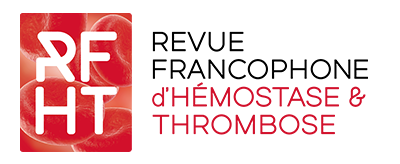RÉSUMÉ
Le principe des traitements anticoagulants actuels repose sur l’inhibition de facteurs clés de la coagulation, comme le complexe prothrombinase via l’inhibition du FX(a), ou le FII(a). L’ensemble de ces traitements, bien que très efficace pour éviter la survenue de thromboses artérielles ou veineuses, a pour principal effet secondaire des saignements dont le plus redouté reste l’hémorragie intracérébrale. Un important effort est donc actuellement mis en place pour trouver de nouveaux anticoagulants présentant moins de risque hémorragique en ciblant plutôt des modulateurs de la génération de thrombine. Nous allons reprendre dans cette revue les éléments physiopathologiques montrant que cibler les facteurs XII(a) ou XI(a) semble être une idée novatrice et pertinente.
MOTS CLÉS
anti-facteur XI, anti-facteur XII, anticoagulants, hémostase, thrombose
ABSTRACT
Current anticoagulant treatments are based on the inhibition of key coagulation actors, such as the prothrombinase complex via the inhibition of FX(a), or FII(a). Although all these treatments are very effective in preventing arterial or venous thrombosis, their main side-effect is bleeding, and the most feared of which remains intracerebral haemorrhage. A major effort is currently underway to find new anticoagulants with lower bleeding risk by targeting modulators of thrombin generation instead. In this review, we will summarize the physiopathological elements that make targeting factors XII(a) or XI(a) an innovative and relevant idea.
KEYWORDS
anti-factor XI, anti-factor XII, anticoagulant, hemostasis, thrombosis

